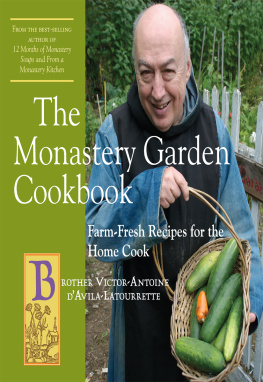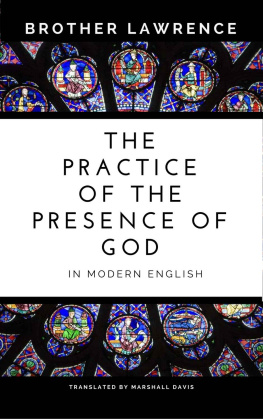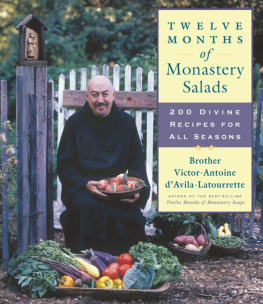Victor-Antoine dAvila-Latourrette - The Monastery Garden Cookbook: Farm-Fresh Recipes for the Home Cook
Here you can read online Victor-Antoine dAvila-Latourrette - The Monastery Garden Cookbook: Farm-Fresh Recipes for the Home Cook full text of the book (entire story) in english for free. Download pdf and epub, get meaning, cover and reviews about this ebook. year: 2011, publisher: Countryman Press, genre: Home and family. Description of the work, (preface) as well as reviews are available. Best literature library LitArk.com created for fans of good reading and offers a wide selection of genres:
Romance novel
Science fiction
Adventure
Detective
Science
History
Home and family
Prose
Art
Politics
Computer
Non-fiction
Religion
Business
Children
Humor
Choose a favorite category and find really read worthwhile books. Enjoy immersion in the world of imagination, feel the emotions of the characters or learn something new for yourself, make an fascinating discovery.
- Book:The Monastery Garden Cookbook: Farm-Fresh Recipes for the Home Cook
- Author:
- Publisher:Countryman Press
- Genre:
- Year:2011
- Rating:4 / 5
- Favourites:Add to favourites
- Your mark:
The Monastery Garden Cookbook: Farm-Fresh Recipes for the Home Cook: summary, description and annotation
We offer to read an annotation, description, summary or preface (depends on what the author of the book "The Monastery Garden Cookbook: Farm-Fresh Recipes for the Home Cook" wrote himself). If you haven't found the necessary information about the book — write in the comments, we will try to find it.
Brother Victor offers more simple and elegant vegetable recipes.
Keeping simple, homegrown elegance at the center of his culinary approach, Brother Victor has delighted the worlds palate and its soul through the success of his books From a Monastery Kitchen and Twelve Months of Monastery Soups. On the heels of 2010s The Pure Joy of Monastery Cooking, his first fully illustrated cookbook, Brother Victor revives one of his classics, Fresh from a Monastery Garden, originally published in 1998.These 200 vegetable recipes come direct from his kitchen at Our Lady of the Resurrection Monastery to yours. They rely on the vibrancy of flavors and aromas and stay true to Brother Victors belief in being kind to the Earth. If youve never tried Brother Victors clean, healthy approach to cooking, its high time you did.
Dishes borrow the richness of his southern French culinary tradition, with recipes like Fennel Ratatouille, Asparagus Risotto, and Alsatian Tomato Salad. Youll also find techniques for canning and preserving fruits, vegetables, such treasures as AppleSweet Potato Chutney and Corn Relish.
The Monastery Garden Cookbook celebrates vegetables, offering a lifetime of deliciously healthy eating. Formerly published under the title Fresh from a Monastery Garden.
Victor-Antoine dAvila-Latourrette: author's other books
Who wrote The Monastery Garden Cookbook: Farm-Fresh Recipes for the Home Cook? Find out the surname, the name of the author of the book and a list of all author's works by series.





















